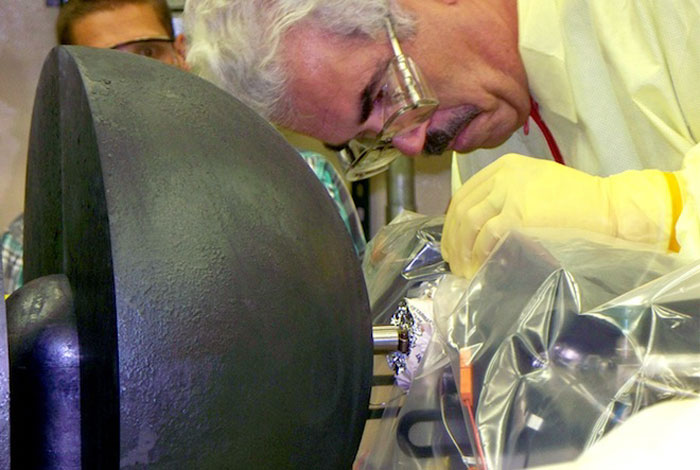-

A proposed deep-space probe to Jupiter that uses the radioactive nuclear engine proposed at NASA and Los Alamos. Los Alamos National Laboratory
-
Researchers have tested a small prototype of a nuclear-reactor engine design that could one day power deep-space exploration probes.
The proposed design is based on a Stirling engine – an engine first invented in the 19th century that uses hot pressurized gas to push a piston. It would use a 50-pound nuclear uranium battery to generate heat that is then carried to eight Stirling engines to produce about 500 watts of power.
Scientists at NASA’s Glenn Research Center and Los Alamos National Laboratory have tested a pared-down prototype of this design using a small nuclear source and a single Stirling engine that produced about 24 watts of energy. Most deep-space probes require about 600 to 700 watts of power, so it will still be a while before this early test produces something capable of powering a spacecraft. This is the first test of a nuclear reactor system to power a spacecraft conducted in the U.S. since 1965.
Nuclear engines are important because they make possible exploration of the entire solar system. Beyond Mars, sunlight is so weak that solar panels would have to be football-field-sized in order to eke out enough power to run a spacecraft and transmit data back to Earth.
For the last few decades, NASA has used plutonium-238 to power its deep-space probes, including the Voyager spacecrafts and the Cassini mission currently in orbit around Saturn. But beginning in the early 1980s, the U.S. began decommissioning its plutonium production sites and by 1992 had no way to generate new plutionium-238. NASA’s Curiosity rover, which is right now driving around Mars, carried some of the last bits of American plutonium with it to the Red Planet.
In 2011, NASA and the Department of Energy received about $10 million to restart plutonium production, and should soon be capable of generating a few pounds of the material each year. This tiny amount will be highly coveted for deep-space missions. A nuclear Stirling engine that generates electricity using more-abundant uranium would reduce the demand for plutonium-238.
If they are created, such reactors would help keep scientists busy exploring the giant outer planets and all their moons for decades to come. Stirling engines could also be used to power a robotic probe on Venus, generating enough power to keep the machine cool in the midst of the planet’s hellish surface temperatures.
-

Los Alamos engineer John Bounds tests a prototype nuclear reactor engine. NASA
-
Quelle: NASA
6544 Views
